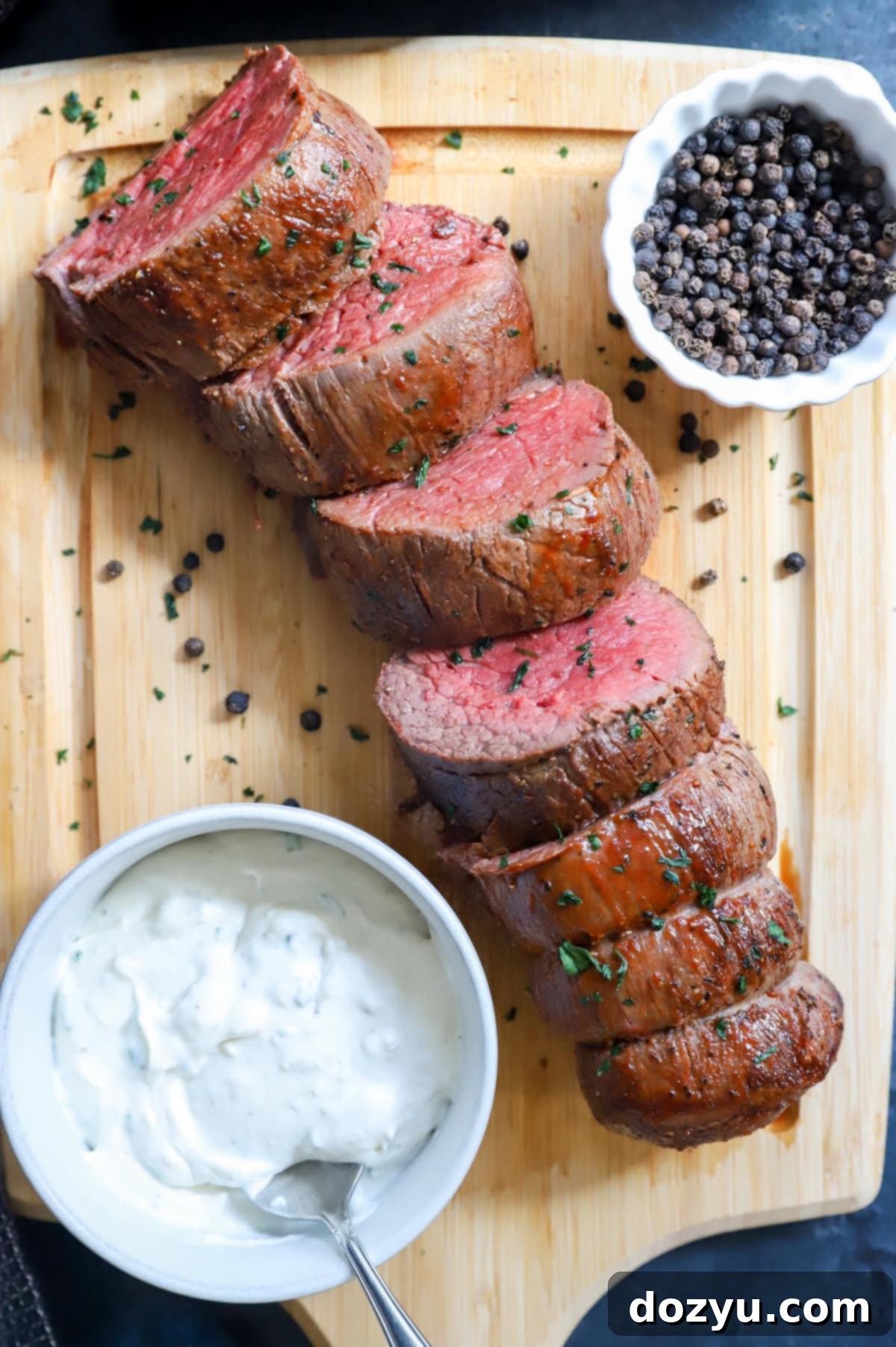The Ultimate BBQ Beef Tenderloin: An Elegant & Simple Holiday Centerpiece
Elevate your holiday season or any special occasion with this show-stopping BBQ Beef Tenderloin. It’s incredibly easy to prepare, yet delivers an impressive, gourmet experience. Served with a vibrant creamy horseradish sauce, this succulent beef tenderloin is destined to be the star of your next gathering.

Disclosure: This post is sponsored by Head Country Bar-B-Q. As always, all opinions are my own.
table of contents
Toggle
About This BBQ Beef Tenderloin Recipe
There’s something truly special about serving a beautifully cooked beef tenderloin. This dish instantly elevates any meal, making it ideal for festive holiday dinners, anniversaries, or any occasion where you want to impress without the stress. While a beef tenderloin might seem daunting to prepare, rest assured, I’m here to guide you through every step to achieve absolute perfection. You’ll be amazed at how simple it is to create this luxurious dish right in your own kitchen.
Many home cooks shy away from beef tenderloin due to concerns about cooking it to the right temperature. The secret, however, is not a complex technique but a reliable meat thermometer. This simple tool takes all the guesswork out of the process, ensuring your tenderloin is cooked precisely to your desired doneness, yielding a juicy and tender result every time. Beyond temperature control, this BBQ beef tenderloin recipe is surprisingly straightforward, relying on robust flavors rather than elaborate methods.
Forget complicated glazes or extensive homemade spice rubs. For the exterior of this stunning BBQ beef tenderloin, we’re embracing the power of three fundamental ingredients: a generous seasoning of coarse salt and freshly cracked black pepper, complemented by the rich, tangy, and subtly sweet notes of Head Country Original BBQ Sauce. This trio works in harmony to create an unforgettable flavor profile that perfectly accentuates the beef.
Head Country Original BBQ Sauce is celebrated for its signature balance of sweet, smoky, and savory flavors. This makes it an absolutely ideal partner for the inherently rich and tender qualities of beef tenderloin. Its classic taste profile ensures a familiar yet elevated experience, perfect for a special dinner. The sauce caramelizes beautifully during cooking, forming a delicious crust that seals in moisture and adds incredible depth of flavor.
For those who love to experiment, Head Country offers a fantastic range of signature BBQ sauces, each capable of transforming the flavor profile of your beef tenderloin. Looking for a deeper, wood-fired taste? Their Hickory Smoke BBQ Sauce would be an excellent choice, adding a distinct layer of smokiness that truly enhances the beef. Feel free to explore and find your favorite combination!
While I chose to prepare this BBQ beef tenderloin in the oven, primarily due to the chilly Colorado weather, this recipe is remarkably versatile. It translates beautifully to the grill, offering a fantastic option for warmer climates or if you simply prefer that authentic outdoor BBQ flavor. I’ve included comprehensive instructions for both oven roasting and grilling later in this post, ensuring you can achieve perfect results regardless of your chosen cooking method. This flexibility makes it a perfect dish for any time of year.
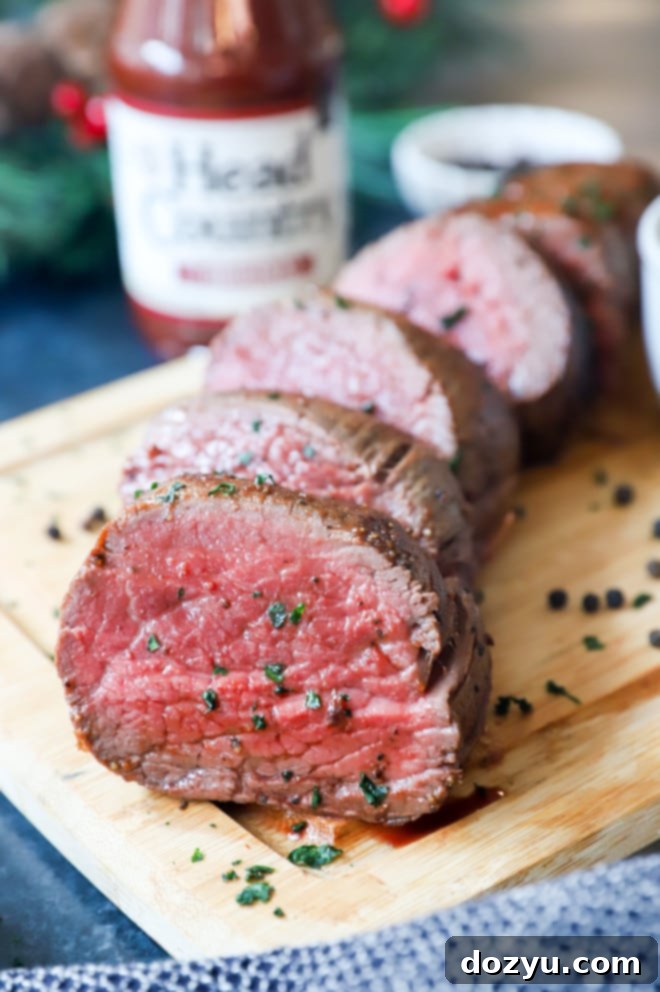
Key Ingredients for Perfect BBQ Beef Tenderloin
Crafting this exquisite BBQ beef tenderloin requires a thoughtful selection of ingredients, ensuring both the beef and its accompanying horseradish sauce reach their full potential.
- BBQ Sauce: The cornerstone of our flavor profile. I wholeheartedly recommend Head Country Original BBQ Sauce. Its perfectly balanced blend of sweet, savory, and spicy notes creates an ideal complement to the rich beef, whether you choose to roast it in the oven or grill it. The sauce develops a wonderful caramelization during cooking, enhancing the overall taste and texture.
- Beef Tenderloin: You’ll need a high-quality 4 to 5-pound whole beef tenderloin. To ensure even cooking and easier handling, I suggest asking your butcher to cut it into two roughly 2-pound center-cut pieces. It’s crucial that the tenderloin is properly trimmed, meaning the “silverskin” and any significant excess fat have been removed. Always confirm this with your butcher. You can also ask them to tie the tenderloin for you, or you can easily do it yourself at home (instructions provided below). Tying helps the meat maintain a uniform shape, which is key for consistent doneness.
- Salt and Pepper: Do not underestimate the importance of proper seasoning. A generous application of coarse sea salt and freshly cracked black pepper is essential. These aren’t just for taste; they work to enhance the natural flavors of the beef and contribute to the formation of a beautiful crust during searing.
- Sour Cream: This forms the creamy, tangy base for our irresistible horseradish sauce. Opt for full-fat sour cream for the richest texture and flavor.
- Horseradish: The star of the creamy sauce, bringing that characteristic pungent kick. Prepared horseradish, readily available in most grocery stores, is perfect for this recipe. If you’re feeling adventurous, you can grate fresh horseradish, but store-bought works wonderfully for convenience.
- Mayonnaise: Adding mayonnaise to the horseradish sauce contributes to its velvety texture and helps to mellow the sharpness of the horseradish, creating a perfectly balanced condiment. Any good quality mayonnaise will do.
- Chives: Freshly chopped chives are vital for brightening the creamy horseradish sauce with their delicate oniony flavor and vibrant green color. While dried chives can be used in a pinch, fresh is highly recommended for the best taste. If using dried, remember to halve the quantity as their flavor is more concentrated.

Essential Equipment for This Recipe
Having the right tools can make all the difference in ensuring a smooth and successful cooking experience. Here’s what you’ll need to prepare this BBQ beef tenderloin:
- Butcher’s Twine and Kitchen Shears: These are indispensable for tying your beef tenderloin. Tying helps the tenderloin maintain a uniform cylindrical shape, ensuring that it cooks evenly from end to end. Without it, thinner sections might overcook while thicker parts are still underdone.
- Cast Iron Skillet (or other oven-safe, heavy-duty skillet): A high-quality, heavy-bottomed skillet, particularly cast iron, is perfect for this recipe. It allows you to sear the beef tenderloin on the stovetop to develop a beautiful, flavorful crust (the Maillard reaction) and then transfer it directly to the oven for roasting. This minimizes cleanup and ensures consistent heat distribution.
- Silicone Brush: Essential for evenly brushing the Head Country BBQ sauce onto the tenderloin. A silicone brush is heat-resistant and easy to clean, making it ideal for applying glazes during cooking.
- Sharp Butcher’s Knife: After resting, a sharp butcher’s knife will allow you to slice the BBQ beef tenderloin cleanly and effortlessly, preserving its juices and presenting it beautifully. A dull knife can tear the meat, leading to a less appealing presentation and potentially drier slices.
- Digital Meat Thermometer: This is arguably the most critical tool for cooking beef tenderloin perfectly. An instant-read digital thermometer will accurately measure the internal temperature of the meat, allowing you to achieve your desired level of doneness without guessing.
- Small Mixing Bowl, Spoon, or Whisk: For preparing the creamy horseradish sauce. A small bowl and a simple spoon or whisk are all you need to combine the ingredients smoothly.



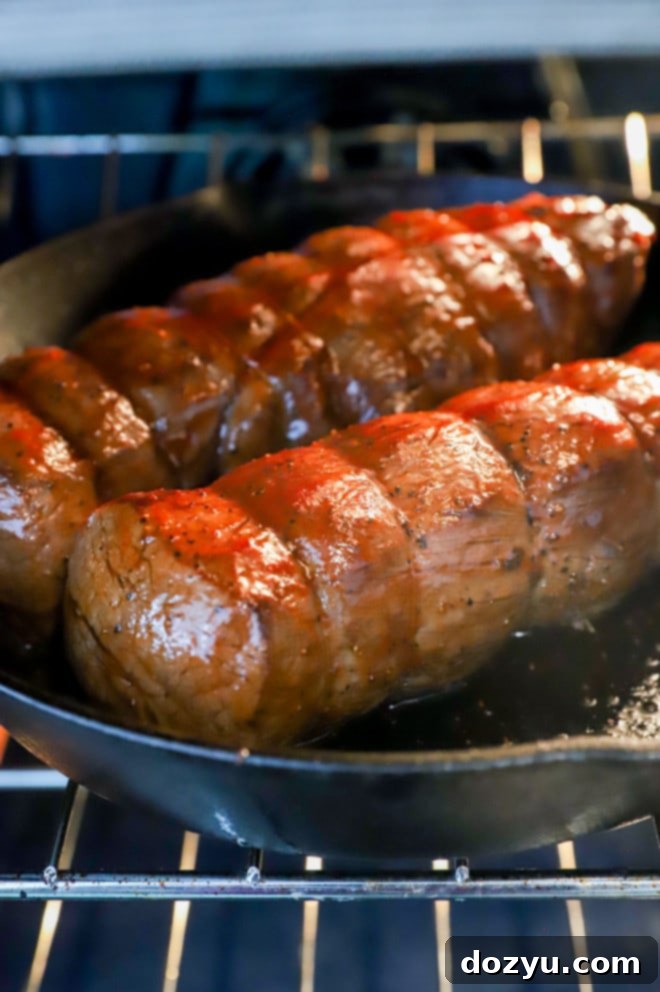
Step-by-Step: How to Make BBQ Beef Tenderloin
Follow these detailed steps to create a truly memorable BBQ beef tenderloin that will delight your guests.
1. Prepare the Creamy Horseradish Sauce
In a small bowl, combine the sour cream, prepared horseradish, mayonnaise, salt, black pepper, and fresh chives. Stir until all ingredients are well incorporated and the sauce is smooth. Cover the bowl and refrigerate the sauce while you prepare the beef. Allowing it to chill allows the flavors to meld beautifully and ensures it’s perfectly cool and refreshing when served alongside the warm tenderloin.
2. Proper Beef Tenderloin Preparation
Before you begin, ensure your beef tenderloin is properly trimmed. This usually involves removing the “silverskin”—a tough, silvery membrane that won’t break down during cooking. To do this, gently slide a sharp, thin knife underneath one end of the silverskin and pull it upwards with your other hand while carefully slicing along its length, separating it from the meat. Trim off any noticeable excess fat around the exterior, as well as any fatty strips running along the sides. A well-trimmed tenderloin cooks more evenly and is more pleasant to eat.
To help the tenderloin cook uniformly, it’s essential to tie it with butcher’s twine. Start by tying a simple knot at one end, then create even segments (every 1-2 inches) down the length of the meat using simple, snug knots. The goal is to make the tenderloin as uniform in thickness as possible. This prevents thinner sections from overcooking before thicker parts are done. Once tied, trim any excess string. For optimal results, allow the tenderloin to come to room temperature for about an hour before cooking. This ensures a more even cook and prevents the outside from scorching while the inside remains cold.

3. Sear, Roast, or Grill to Perfection
Once your beef tenderloin is prepped, it’s time to create that irresistible crust. Pat the tenderloin dry with paper towels to remove any surface moisture, which is crucial for effective searing. Generously season all sides with coarse sea salt and freshly cracked black pepper. Preheat your oven to 425˚F (220˚C).
Heat olive oil in a large, oven-safe skillet (like cast iron) over medium-high heat until it shimmers. Carefully place the seasoned beef tenderloin in the hot skillet and sear it for 2 to 3 minutes per side, turning with tongs to ensure all sides are beautifully browned. This searing step, known as the Maillard reaction, creates a rich, complex flavor and a desirable crust.
After searing, remove the skillet from the heat. Using a silicone brush, generously coat the entire tenderloin with Head Country Original BBQ Sauce. The sauce will begin to caramelize, adding a fantastic layer of flavor and a glossy finish. Transfer the skillet directly into the preheated oven.
Roast the beef tenderloin for approximately 15 to 25 minutes, or until it reaches your desired internal temperature. Halfway through the roasting time (around 10-12 minutes), brush the tenderloin with another layer of BBQ sauce to build up the glaze. The cooking time will vary depending on the thickness of your tenderloin and your preferred doneness. Always use a reliable digital meat thermometer inserted into the thickest part of the meat to ensure accuracy.
Once the desired temperature is reached, remove the tenderloin from the oven. This next step is crucial for juiciness: let the beef rest on a cutting board for at least 15 minutes, tented loosely with foil. Resting allows the juices to redistribute throughout the meat, resulting in a more tender and flavorful final product. After resting, remove the twine, slice against the grain, and serve immediately with the chilled creamy horseradish sauce.
Note: If you prefer to grill your beef tenderloin, specific instructions are provided in the recipe card below, covering how to achieve that perfect char and internal temperature.
More tasty holiday dinner recipes to try: Gnocchi Bolognese Bake | Roasted Chicken with White Wine and Fresh Herbs | Herb Crusted Rack of Lamb | Beer Brined Turkey Breast

Should You Sear Beef Tenderloin Before Roasting?
Absolutely, searing your beef tenderloin before roasting is a highly recommended and crucial step! This initial high-heat exposure accomplishes several important things that significantly enhance the final dish.
Firstly, searing creates a phenomenal, flavorful crust on the exterior of the meat. This isn’t just about texture; it’s about flavor. The intense heat triggers the Maillard reaction – a chemical process that transforms the amino acids and sugars on the surface of the beef, creating hundreds of new flavor compounds. This rich, savory crust is what gives the tenderloin incredible depth and complexity, acting as a perfect foundation for the BBQ sauce glaze.
Secondly, searing locks in the juices. While some might believe searing “seals” in moisture, the primary benefit is actually developing that crust, which then helps to prevent excessive moisture loss during the longer roasting process. It gives the meat a more robust outer layer that stands up beautifully to the sweet and tangy BBQ sauce.
Finally, a quick sear can indeed contribute to reducing the overall cooking time in the oven. By jump-starting the cooking process with high heat, you shorten the subsequent roasting period, helping to keep the interior more tender and less prone to drying out. So, while it adds a few extra minutes on the stovetop, the benefits in flavor, texture, and efficiency are well worth the effort.
Can This Beef Tenderloin Be Grilled?
Yes, absolutely! Grilling beef tenderloin is a fantastic alternative that imparts a wonderful smoky flavor and a beautiful char, making it perfect for an outdoor feast. If you opt for grilling, you’ll adjust the cooking method slightly compared to oven roasting.
When grilling, you will skip the initial stovetop sear. Instead, you’ll start the tenderloin over indirect heat, allowing it to cook more gently and evenly. Toward the end of the cooking process, you’ll crank up the heat to direct grilling to achieve that desirable crispy crust and char. This reverse-sear method helps ensure a tender interior while still getting that signature grilled exterior.
Grilling does typically take a bit longer than roasting in the oven, primarily because you’re working with lower, more controlled heat for a significant portion of the cooking time. However, the unique smoky flavor and char marks that develop on the grill are undeniably delicious and well worth the wait. It creates a different, yet equally impressive, culinary experience.
I’ve provided detailed, step-by-step grilling instructions in the notes section of the recipe card below. This ensures you have all the guidance needed to master this BBQ beef tenderloin on the grill, achieving a succulent, perfectly cooked result every time.
Ensuring Perfect Doneness: How to Tell When It’s Ready
The key to a truly exceptional beef tenderloin lies in cooking it to the perfect internal temperature. While personal preference plays a role, beef tenderloin is most often enjoyed medium-rare, as this ensures maximum tenderness and juiciness. A reliable digital meat thermometer is your best friend here, taking all the guesswork out of the process.
Insert the thermometer into the thickest part of the tenderloin, making sure it doesn’t touch any bone or the cooking surface. Here are the target internal temperatures for different levels of doneness:
- Rare: 125˚F (52˚C) – Very red, cool center.
- Medium Rare: 135˚F (57˚C) – Bright red, warm center. This is often considered the ideal doneness for tenderloin, offering the best balance of flavor and texture.
- Medium: 145˚F (63˚C) – Pink, warm center.
- Medium Well: 155˚F (68˚C) – Slightly pink, hot center.
- Well Done: 160˚F (71˚C) – Little to no pink, hot throughout. Be aware that cooking beyond medium-well can result in a tougher, drier texture for tenderloin.
Pro Tip: Remember that beef, especially a large cut like tenderloin, will continue to cook slightly after it’s removed from the heat. This is called “carryover cooking.” The internal temperature can rise an additional 5 to 10 degrees Fahrenheit (3-5 degrees Celsius) during the resting period. Therefore, it’s wise to remove the tenderloin from the oven or grill just before it reaches your target final temperature. For example, if you aim for medium-rare at 135˚F, pull it around 125-130˚F.
Need some more inspiration for dinner? Check out my main dish recipes page!
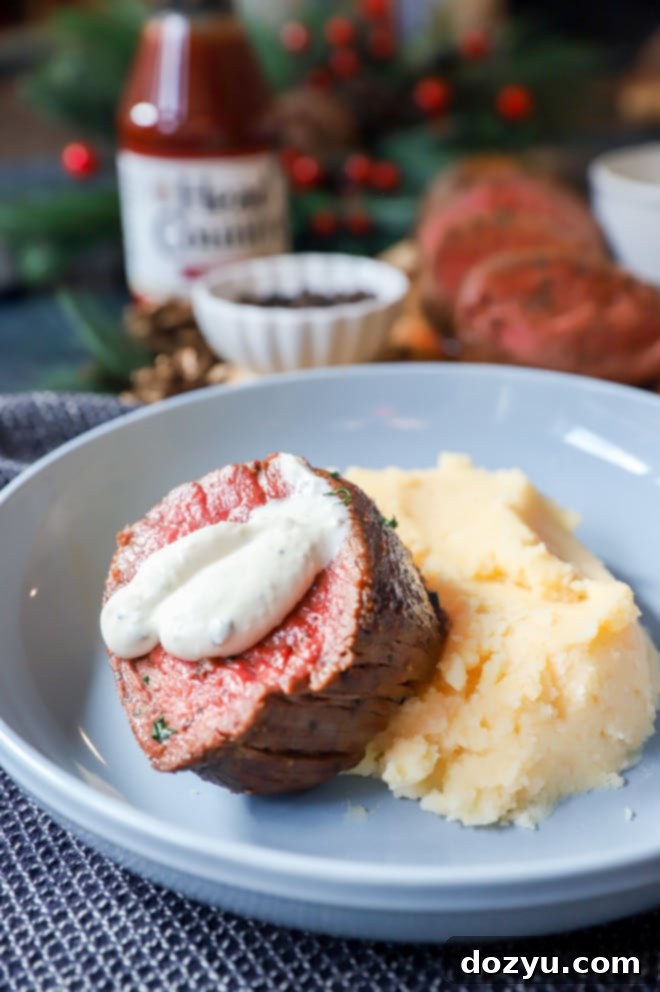
Delicious Sides to Serve with BBQ Beef Tenderloin
BBQ beef tenderloin is a versatile main course that pairs wonderfully with a wide array of side dishes. While a classic potato and green vegetable combination is always a winner, don’t hesitate to get creative. The creamy horseradish sauce adds a zesty contrast to the rich beef, allowing for both hearty and lighter side options.
Here are some of my personal favorites from the blog that complement this elegant dish perfectly:
- Crispy Brussels Sprouts with Balsamic and Lemon: These tangy and slightly spicy Brussels sprouts offer a fantastic textural contrast and cut through the richness of the beef.
- Instant Pot Mashed Potatoes with Roasted Garlic and Parmesan: The easiest way to achieve creamy, flavorful mashed potatoes. Their smooth texture is a delightful pairing with the tender beef.
- Spicy-Sweet Roasted Broccolini: Fresh, vibrant, and incredibly easy to throw together, this broccolini adds a touch of sweetness and a hint of spice.
- Crispy Golden Brown Smashed Fingerling Potatoes: Drizzled with an aromatic herb butter that seeps into every nook and cranny, these potatoes offer a satisfying crispy exterior and a fluffy interior.
- Garlic Butter Roasted Potatoes and Carrots: A hearty and comforting side that requires minimal ingredients and delivers maximum flavor, perfect for soaking up any delicious beef juices.
- Sweet and Savory Honey Roasted Carrots and Parsnips: These root vegetables are incredibly simple to prepare in the oven and provide a lovely earthy sweetness that balances the BBQ flavors.
- Air Fryer Hasselback Sweet Potatoes: For a unique and visually appealing potato side, these air fryer sweet potatoes are easy to make and offer a wonderful blend of sweet and savory.
If creamy horseradish isn’t your preference, consider whipping up an easy homemade au jus recipe to serve alongside the tenderloin. This light, savory sauce enhances the beef’s natural flavors without overpowering them.
Beyond the holidays, this recipe also makes for a standout main dish for any Valentine’s Day menu, offering a romantic and impressive meal for two (or more!).
The Perfect Sweet Ending: Dessert Ideas
No holiday or special meal is complete without a delightful dessert. After the rich and savory BBQ beef tenderloin, something sweet and satisfying is the perfect conclusion. For many, nothing quite encapsulates the spirit of the holidays like a beautiful plate of holiday cookies!
Our site boasts an extensive collection of cookie recipes to suit every taste. From the buttery melt-in-your-mouth goodness of milk chocolate shortbread to the festive charm of snowball cookies, or the chewy delight of cranberry white chocolate oatmeal cookies, and the colorful layers of Italian rainbow cookies – you’ll find everything you need to assemble an impressive and delicious treat platter. These are perfect for sharing, gifting, or simply enjoying with a cup of coffee after your meal.
If you’re seeking a more elegant and sophisticated grand finale, our San Sebastian cheesecake is an absolute must-try. This “burnt” Basque cheesecake offers a uniquely caramelized exterior with an incredibly creamy, custardy interior. It’s surprisingly easy to make, delivering a high-impact dessert that will leave a lasting impression on your guests with its refined flavor and striking appearance.
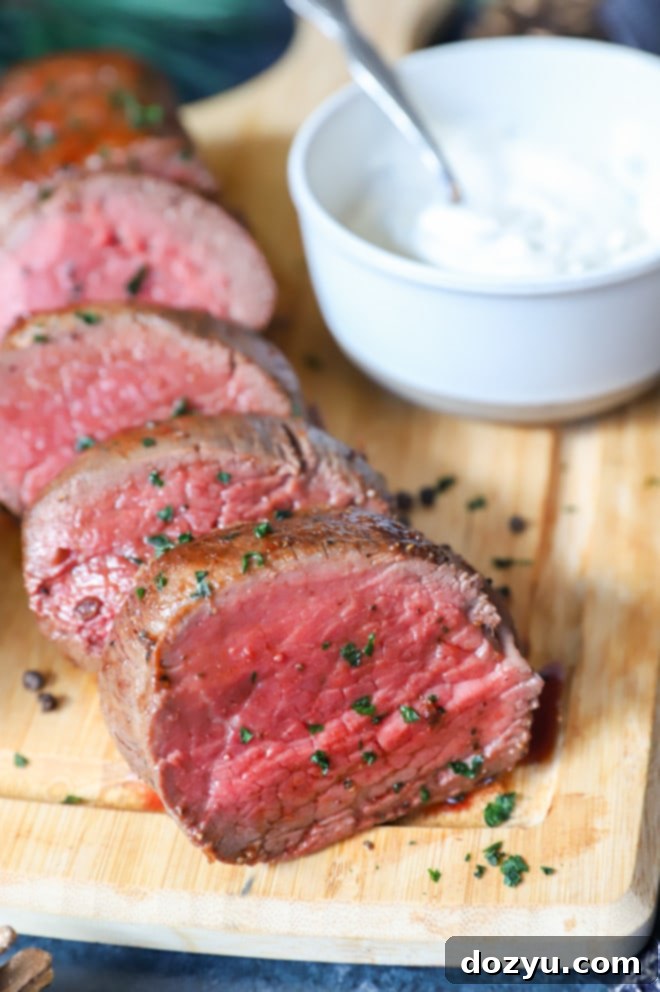
Finally, if you prepare this incredible BBQ beef tenderloin recipe, please take a moment to give it a rating or leave a comment below! I genuinely love hearing about your cooking experiences and always make an effort to respond to every single comment. Your feedback is invaluable, and don’t hesitate to drop any questions you might have about the recipe.
And of course, be sure to tag me on Instagram if you share photos of your culinary creation! Seeing these recipes come to life in your homes brings me so much joy – it truly means the world to me!

BBQ Beef Tenderloin
15 minutes
35 minutes
50 minutes
8
Equipment
-
Wusthof 8″ Artisan Butcher Knife, Hollow Edge
-
French Wire Whisk
-
Small Glass Bowls
-
Le Creuset Signature Iron Handle Skillet (or other oven-safe cast iron skillet)
-
Digital Meat Thermometer
-
Butcher’s Twine
-
Kitchen Shears
-
Silicone Pastry Brush
Ingredients
- 1/2 cup sour cream
- 2 tbsp prepared horseradish
- 2 tbsp mayonnaise
- 1/4 tsp salt
- 1/8 tsp black pepper
- 1 tbsp chives freshly chopped
- 4 to 5- pound beef tenderloin trimmed, optionally cut into two pieces, and tied
- 2 Tbsp olive oil
- Coarse sea salt to taste
- Freshly cracked black pepper to taste
- 1/2 cup to 1 cup Head Country Original BBQ Sauce
Instructions
-
Allow beef tenderloin to come to room temperature for about 1 hour before cooking for more even results.
-
Preheat your oven to 425˚F (220˚C). Ensure your tenderloin is trimmed of silverskin and excess fat, then tie it into even segments with butcher’s twine.
-
To make the creamy horseradish sauce, combine all sauce ingredients (sour cream, prepared horseradish, mayo, salt, pepper, chives) in a small bowl. Stir well and refrigerate until ready to serve.
-
Pat any excess moisture from the beef tenderloin thoroughly with paper towels. Season generously on all sides with coarse sea salt and freshly cracked black pepper.
-
Heat olive oil in a large, oven-safe cast iron skillet over medium-high heat. Once the oil is shimmering, carefully place the beef tenderloin in the skillet. Sear for 2 to 3 minutes per side, turning with tongs until all sides are browned (approximately 10 minutes total).
-
Remove the skillet from the heat. Using a silicone brush, generously coat the entire beef tenderloin with Head Country Original BBQ Sauce.
-
Transfer the skillet to the preheated oven. Roast for 15 to 25 minutes total, or until it reaches your desired doneness (refer to the doneness guide in the main post). After the first 10 minutes of roasting, brush the beef tenderloin with another coat of BBQ sauce. Use a digital meat thermometer to accurately gauge the internal temperature in the thickest part of the meat.
-
Once cooked, remove the beef tenderloin from the oven and transfer it to a cutting board. Let it rest for at least 15 minutes, tented loosely with foil. This critical step allows the juices to redistribute, ensuring a tender and flavorful result. After resting, remove the twine, slice against the grain, and serve immediately with the creamy horseradish sauce.
Video
Notes
Nutrition
737kcal
Holiday
Main Dish
